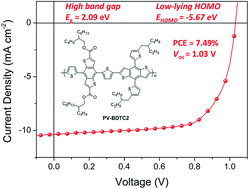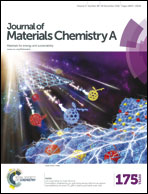Wide bandgap copolymers with vertical benzodithiophene dicarboxylate for high-performance polymer solar cells with an efficiency up to 7.49%†
Abstract
In aiming to build novel wide band-gap high-performance photovoltaic donor materials, a vertical benzo[1,2-b:4,5-b′]dithiophene-2,6-dicarboxylate (V-BDTC) with a weak electron-withdrawing character was primarily developed. And its wide band-gap (WBG) copolymers PV-BDTC1 and PV-BDTC2 were designed and synthesized, which contain a traditional electron-donating unit of 4,8-disubstituted benzo[1,2-b:4,5-b′] dithiophene (BDT) derivative with diethylhexyloxy for the former and diethylhexylthiophenyl for the latter. It is found that the weak electron-withdrawing V-BDTC unit endows its copolymers with a WBG up to 2.09 eV and a deep HOMO energy level of ∼5.67 eV. Furthermore, PV-BDTC2 exhibits much better photovoltaic properties than PV-BDTC1 in the solution-processing polymer solar cells (PSCs) with a higher open-circuit voltage (Voc) of 1.03 V and an increased power conversion efficiency (PCE) of 7.49%. To the best of our knowledge, this PCE value is the highest level recorded for copolymers with a WBG over 2.0 eV in the PSCs to date, along with a remarkable Voc over 1.0 V. This work provides a feasible strategy to develop a novel promising electron-withdrawing building block and its high-performance WBG copolymers based on the BDT unit.

- This article is part of the themed collection: 2016 Journal of Materials Chemistry A HOT Papers

 Please wait while we load your content...
Please wait while we load your content...